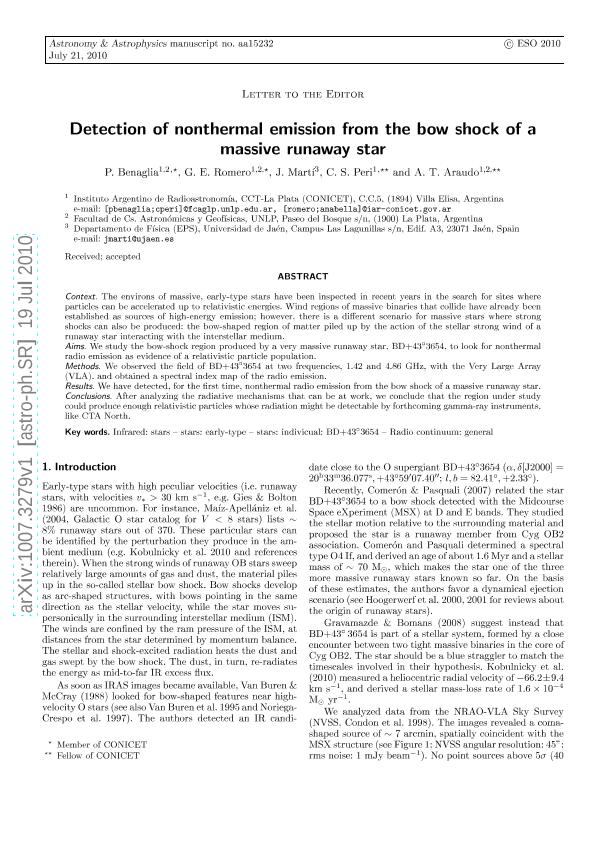Mostrar el registro sencillo del ítem
dc.contributor.author
Benaglia, Paula

dc.contributor.author
Romero, Gustavo Esteban

dc.contributor.author
Martí, Josep
dc.contributor.author
Peri, Cintia Soledad

dc.contributor.author
Araudo, Anabella Teresa

dc.date.available
2016-07-04T16:50:31Z
dc.date.issued
2010-07
dc.identifier.citation
Benaglia, Paula; Romero, Gustavo Esteban; Martí, Josep; Peri, Cintia Soledad; Araudo, Anabella Teresa; Detection of nonthermal emission from the bow shock of a massive runaway star; EDP Sciences; Astronomy and Astrophysics; 517; 7-2010; 10-13
dc.identifier.issn
0004-6361
dc.identifier.uri
http://hdl.handle.net/11336/6326
dc.description.abstract
Context. With the latest infrared surveys, the number of massive protostellar candidates has increased significantly. New studies have posed additional questions on important issues about the formation, evolution, and other phenomena related to them. Complementary to infrared data, radio observations are a good tool to study the nature of these objects, and to diagnose the formation stage. Aims: Here we study the far-infrared source IRAS 16353-4636 with the aim of understanding its nature and origin. In particular, we search for young stellar objects (YSOs), possible outflow structure, and the presence of non-thermal emission. Methods: Using high-resolution, multi-wavelength radio continuum data obtained with the Australia Telescope Compact Array, we image IRAS 16353-4636 and its environment from 1.4 to 19.6 GHz, and derive the distribution of the spectral index at maximum angular resolution. We also present new JHKs photometry and spectroscopy data obtained at ESO NTT. 13CO and archival H I line data, and infrared databases (MSX, GLIMPSE, MIPSGal) are also inspected. Results: The radio continuum emission associated with IRAS 16353-4636 was found to be extended (~10 arcsec), with a bow-shaped morphology above 4.8 GHz, and a strong peak persistent at all frequencies. The NIR photometry led us to identify ten near-IR sources and classify them according to their color. We used the H I line data to derive the source distance, and analyzed the kinematical information from the CO and NIR lines detected. Conclusions: We have identified the source IRAS 16353-4636 as a new protostellar cluster. In this cluster we recognized three distinct sources: a low-mass YSO, a high-mass YSO, and a mildly confined region of intense and non-thermal radio emission. We propose the latter corresponds to the terminal part of an outflow.
dc.format
application/pdf
dc.language.iso
eng
dc.publisher
EDP Sciences

dc.rights
info:eu-repo/semantics/openAccess
dc.rights.uri
https://creativecommons.org/licenses/by-nc-nd/2.5/ar/
dc.subject
Early-Type Stars
dc.subject
Bd+43 3654 (Estrella)
dc.subject
Radio Continuum
dc.subject
Infrared Stars
dc.subject.classification
Astronomía

dc.subject.classification
Ciencias Físicas

dc.subject.classification
CIENCIAS NATURALES Y EXACTAS

dc.title
Detection of nonthermal emission from the bow shock of a massive runaway star
dc.type
info:eu-repo/semantics/article
dc.type
info:ar-repo/semantics/artículo
dc.type
info:eu-repo/semantics/publishedVersion
dc.date.updated
2016-06-15T19:20:09Z
dc.journal.volume
517
dc.journal.pagination
10-13
dc.journal.pais
Francia

dc.journal.ciudad
Paris
dc.description.fil
Fil: Benaglia, Paula. Consejo Nacional de Investigaciones Científicas y Técnicas. Centro Científico Tecnológico la Plata. Instituto Argentino de Radioastronomia (i); Argentina. Universidad Nacional de la Plata. Facultad de Ciencias Astronómicas y Geofísicas; Argentina
dc.description.fil
Fil: Romero, Gustavo Esteban. Consejo Nacional de Investigaciones Científicas y Técnicas. Centro Científico Tecnológico la Plata. Instituto Argentino de Radioastronomia (i); Argentina. Universidad Nacional de la Plata. Facultad de Ciencias Astronómicas y Geofísicas; Argentina
dc.description.fil
Fil: Martí, Josep. Universidad de Jaén; España
dc.description.fil
Fil: Peri, Cintia Soledad. Consejo Nacional de Investigaciones Científicas y Técnicas. Centro Científico Tecnológico la Plata. Instituto Argentino de Radioastronomia (i); Argentina
dc.description.fil
Fil: Araudo, Anabella Teresa. Consejo Nacional de Investigaciones Científicas y Técnicas. Centro Científico Tecnológico la Plata. Instituto Argentino de Radioastronomia (i); Argentina. Universidad Nacional de la Plata. Facultad de Ciencias Astronómicas y Geofísicas; Argentina
dc.journal.title
Astronomy and Astrophysics

dc.relation.alternativeid
info:eu-repo/semantics/altIdentifier/ark/http://www.aanda.org/articles/aa/abs/2010/09/aa15232-10/aa15232-10.html
dc.relation.alternativeid
info:eu-repo/semantics/altIdentifier/doi/10.1051/0004-6361/201015232
dc.relation.alternativeid
info:eu-repo/semantics/altIdentifier/doi/http://dx.doi.org/10.1051/0004-6361/201015232
dc.relation.alternativeid
info:eu-repo/semantics/altIdentifier/arxiv/1007.3279v1
dc.relation.alternativeid
info:eu-repo/semantics/altIdentifier/url/http://arxiv.org/abs/1007.3279v1
Archivos asociados
